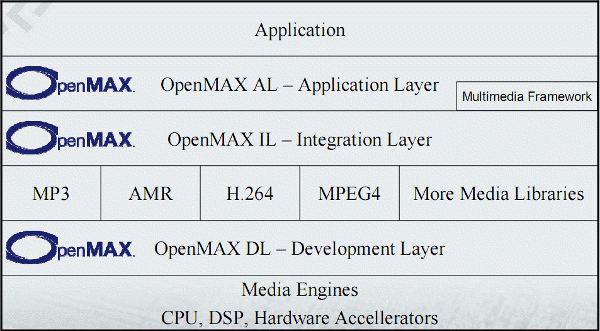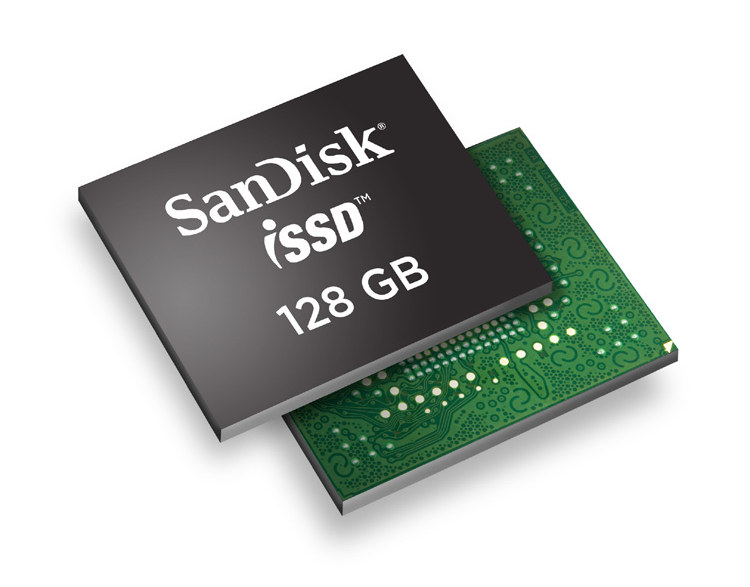OpenMAX (Open Media Acceleration) is a royalty-free, cross-platform set of C-language programming interfaces that provides abstractions for routines especially useful for audio, video, and still images. OpenMAX standard is managed by the non-profit technology consortium Khronos Group. OpenMAX allows developers to take advantages of hardware media decoding/encoding. For example, If you want to play video using Raspberry Pi hardware (VideoCore IV GPU in Broadcom BCM2835) you’ll have to use OpenMAX IL. OpenMAX provides three layers of interfaces: Application Layer (AL): Open standard for accelerating the capture, and presentation of audio, video, and images in multimedia applications on embedded and mobile devices. Integration Layer (IL) : API defining a standardized media component interface to enable developers and platform providers to integrate and communicate with multimedia codecs implemented in hardware or software. Development Layer (DL): APIs containing a comprehensive set of audio, video and imaging functions that can be implemented and optimized […]
Bootloader to OS with Unified Extensible Firmware Interface (UEFI)
Unified Extensible Firmware Interface (UEFI) is a specification detailing an interface that helps hand off control of the system for the pre-boot environment (i.e.: after the system is powered on, but before the operating system starts) to an operating system, such as Windows or Linux. UEFI aims to provides a clean interface between operating systems and platform firmware at boot time, and supports an architecture-independent mechanism for initializing add-in cards. UEFI will overtime replace vendor-specific BIOS. It also allows for fast boot and support for large hard drives (> 2.2 TB). There are several documents fully defining the UEFI Specification, API and testing requirements: The UEFI Specification (version 2.3.1) describes an interface between the operating system (OS) and the platform firmware. It describes the requirements for the following components, services and protocols: Boot Manager Protocols – Compression Algorithm Specification EFI System Table Protocols – ACPI Protocols GUID Partition Table (GPT) […]
What is GENIVI ? A Software Standard for the Automotive Industry
I’ve recently read in the news that a few operating systems had achieved GENIVI compliance. So let’s see what Wikipedia says about the GENIVI Alliance: The GENIVI Alliance was founded on March 2, 2009 by BMW Group, Delphi, GM, Intel, Magneti-Marelli, PSA Peugeot Citroen, Visteon, and Wind River Systems with the goal of establishing a globally competitive, Linux-based operating system, middleware and platform for the automotive in-vehicle infotainment industry. Since then, the alliance has expanded to more than 100 members who are working together to deliver an open and globally consistent software platform based on Linux for use by the whole car industry. So the clear goal here is to have some set of software specifications and standards (Currently GENEVI 1.0) in the automotive industry in order to speed time to market and reduce the cost of developing Infotainment applications. GENIVI comes from a concatenation of Geneva and IVI (In-Vehicle […]
New Revision of C++ Programming Language: C++11
The Final International Draft standard (FCD) was unanimously approved on August 12th, 2011. The standard should be published this year. The draft name of the standard is C++0x, but since it will be published this year, it should probably renamed C++11, and if there are delays in its publication it could well be renamed to C++12. You can download the 1334 pages “Working Draft, Standard for Programming Language C++” to get the full details. If you don’t feel like going thru that massive document, but still want to learn about C++0x, I recommend you check the C++0x FAQ on Bjarne Stroustrup (The creator of C++) homepage. Here are some the new features and improvements: initializer-lists – Initializer lists are not just for arrays any more uniform initialization syntax and semantics template aliases (previously know as template typedef) rvalue references defaulted and deleted functions variadic templates auto – deduction of a type from […]
SATA-IO µSSD Standard for Embedded Solid State Drives
The Serial ATA International Organization (SATA-IO) recently announced a new standard for embedded solid state drives (SSDs) called “SATA µSSD”. This standard offers high-performance, low-cost, embedded storage solutions for mobile computing platforms like ultra-thin laptops. The µSSD specification eliminates the module connector from the traditional SATA Interface, allowing drives to be manufactured in single ball grid array (BGA) packages that sit directly on a motherboard. The new µSSD standard should be part of the SATA Specification. However, it does not seem to be in the latest SATA Specification (Revision 3.1) released in July 2011. This specification is available free of charge to members. For non-members, it can be purchased here for 25 USD. Sandisk is currently the only company providing products that follow the µSSD standard with its iSSD™ integrated storage device offering capacities of 8, 16,32, 64 & 128 GB and transfer throughput of up to 450MB/s via a […]
HbbTV: Hybrid Broadcast Broadband TV
HbbTV (Hybrid Broadcast Broadband TV) is a new European standard for web-based smart TV applications for TVs and set-top boxes. Services and applications delivered via HbbTV include traditional broadcast TV channels, catch-up services, video-on-demand, EPG, interactive advertising, personalisation, voting, games, social networking and other multimedia applications. The latest version of the HbbTV specification is 1.1.1 and can normally be downloaded after registering on ETSI website. The official nomenclature of the specification is ETSI TS 102 796. It is also directly available at the following link – http://www.etsi.org/deliver/etsi_ts/102700_102799/102796/01.01.01_60/ts_102796v010101p.pdf The HbbTV specification is based on existing standards and web technologies including OIPF (Open IPTV Forum), CEA, DVB and W3C. HbbTV Specifications specifically makes use of the following standards: CEA-2014 – Web-based Protocol and Framework for Remote User Interface on UPnP Networks and the Internet (Web4CE), also known as CE-HTML. Open IPTV Forum Release 1 Volume 5 – Declarative Application Environment of the […]
Freescale Wireless Charging Systems
Freescale showcased two wireless charging systems at Mobile World Congress 2011 in Barcelena. The first product – Energizer’ InductiveCharger – is based on Freescale MC56F8006VLC and follows the Qi 1.0 Wireless Charging Standard. You simply need to use a specific casing (with a wireless power receiver) for your mobile device that integrates the necessary hardware to “communicate” with the power pad. The second product – PowerMat – is based on Freescale MC9S08Q2 andMC9S08K4 to provide intelligent control in the charging mat and phone receiver. It does not follow the Qi standard but works basically the same way. Both systems are available on the market and can be purchased on Amazon and other retailers. You’ll normally need to buy two pieces, the mat and the casing for your phone (for around 75 to 100 USD). Powermat also have one position mat together with the receiver for 37 USD. Watch the video […]
MHL: Mobile High Definition Link
Mobile High Definition Link (MHL) is a new standard that allows to connect your MHL-enabled phone to an MHL-enabled device (e.g. a TV) to output video, connect power and allows communication between both device with only one cable (micro-usb to HDMI cable with MHL signalling). The MHL Consortium has just been setup last year by Sony, Toshiba, Samsung, Silicon Image and Nokia. The MHL™ Consortium is committed to enhancing the multimedia capabilities of mobile and portable devices. MHL specification version 1.0 is an HD video and digital audio interface for connecting mobile phones and portable devices to HDTVs and other home entertainment products. It utilizes established connectors and features a single cable with a 5-pin interface, supports 1080p HD video and digital audio, and simultaneously provides power to the mobile device. It also enables the TV remote to control the mobile phone and access its contents. They have a few […]









